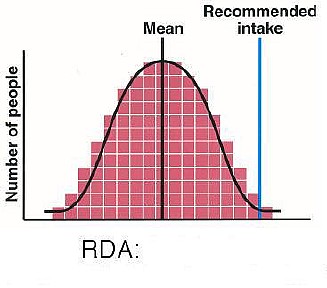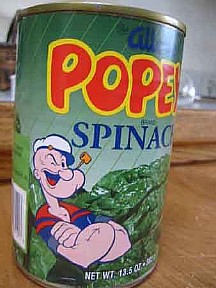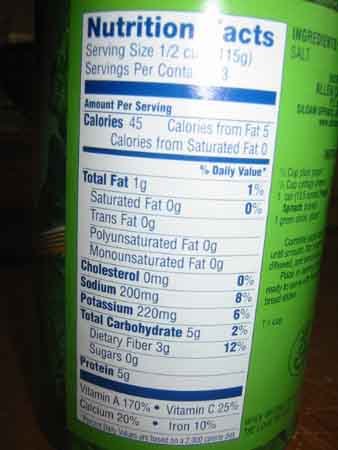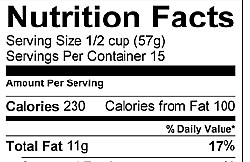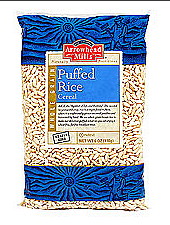|
CORRECTIONS/HIGHLIGHTS/ANNOUNCEMENTS:
When you e-mail me in Moodle please make sure you tell me what class you are in. Also please be specific about what questions you need to have corrected. Great job using the forums to ask and answer questions, remember using the forums will be the quickest way to get an an answer to your question. This term we will be talking about local foods, and sustainable food choices. I wanted to bring to your attention the Learning Garden we have right here on campus: Click on the above link
to see current events taking place in the garden
this term. There are many great opportunities
if you are interested in getting involved and
learning more about gardening. For Exam 1 during Week 3, you should study:
Also there is a study guide posted and an extra credit online review quiz during Week 2 . |
||
FORUM topics for Week 2 I hope you decide to participate. I've
really enjoyed your postings. Remember there
will be exam questions taken from the forums.
Each week in Moodle there is a forum titled, "Student
Questions." Please post your questions here that
you have related to the content of the class instead
of e-mailing me your questions or posting them in the
other weekly forum. If you are having trouble
filling out the lecture outline, or answering study
questions, or just need more explanation on a
particular concept use this forum to get help from
other students, and also the instructor. You are
doing a great job of doing this so keep up the good
work! These topics will
be posted for you to discuss in Week 2:
1) Take a look at a label in your pantry or refrigerator for a snack item. What is the product you looked at? Look at the Nutrition Facts label. What is the serving size? How many Calories per serving? What would a reasonable portion be? How many Calories in this portion? What nutrients is this product a good source of (>10% DV)? Do you feel this product is a nutrient dense choice, or does it have a lot of empty calories?2) Take a look at the link below regarding the new food label. Discuss one change to the label and how you think it will be helpful (or not helpful) to you. https://www.fda.gov/food/nutrition-education-resources-materials/new-and-improved-nutrition-facts-label |
||
|
Chapter 2: Designing
a Healthful Diet
First look through the major headings of this lecture: I (DRI) Dietary Reference Intakes II Daily Values (DV) III Dietary Guidelines for Americans, 2015 IV MyPlate V Beyond the nutrients of the twentieth century You might be thinking this all sounds a
little too technical and IT IS! Or you might be
thinking: How do I know if my diet is giving me the
nutrients I need? How do I
know if I'm getting enough calcium or iron? As I mentioned earlier, the
RDAs (and the AIs) are usually used in clinical or
outpatient settings, where a dietitian might use them
to assess an individual's nutrient intake. They
also may be used to determine a formula prescription
for a tube feeding. You will use them in this
class to assess your own nutrient intake when you
analyze your diet using the MyDietAnalysis website.
For the most part, individual's don't use the RDAs and
AIs, because people eat FOODS not NUTRIENTS, so the
MyPlate and MyDietAnalysis websites are much
more useful guides. That is what we are going to
discuss soon, after we spend a few
minutes on Daily Values.
They are
changing! As of January1, 2020 there are some
important changes that are aimed at helping consumers
better utilize the label to make healthy food choices
and enhance awareness of serving sizes and calories.
For a while you will see the old label on some foods,
and the new label on some foods. That is because only
manufacturers with $10 million
or more in annual sales were required by law to
switch to the new label by January 1, 2020.
Manufacturers with less than $10 million in annual
food sales have until January 1, 2021 to comply. Both labels are
out there so we will continue using the older label
this term. For your information, below a picture of
the new label:
https://www.fda.gov/media/97999/download See this link for more
information: https://www.fda.gov/food/food-labeling-nutrition/changes-nutrition-facts-label
Next, we'll talk about the
Dietary Guidelines and MyPlate, but you
might need a stretch break first! STRETCH BREAK!
Definition-
The plate is a visual representation
of the USDA food guide. It was released in June of
2011, after going through a makeover from the previous MyPyramid. The overall information of MyPlate is similar to MyPyramid, but the format has been modified from a pyramid to a plate. It is a food guide to help Americans achieve the goals of the Dietary Guidelines for Americans, as well as meeting the RDAs and AIs or (DRIs). For most people this means eating MORE:
And LESS:
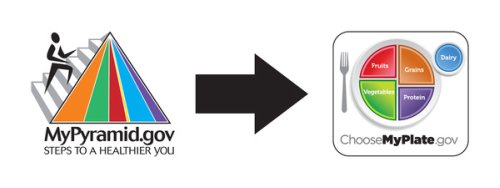 Above is how the icon for the MyPyramid has transitioned to a plate and below is what it looked like when it was first released in 1992. 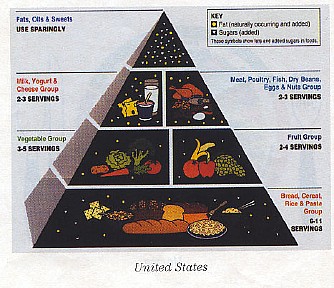 In all three icons above, foods are grouped into 5 different groups, based on their nutrient content.
There are other food guides in other countries,
some in pyramid shapes, plate shapes, or other
shapes. For example, here is Mexico's: 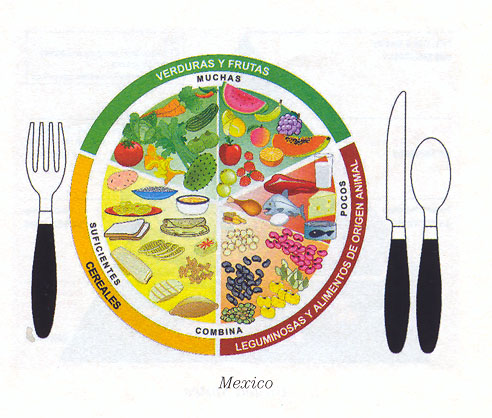 Mexico For more food guides from other
countries, see the following link: http://www.fao.org/nutrition/education/food-based-dietary-guidelines/en |
The first U.S. Food Guide, shown below, was
released in 1917.  The short video clip below talks about it. |
| Food Guide Video Clip (approximately 2-minutes) 1917 Food Guide video |
History of U.S. food grouping systems: about 1917- 5 groups WWII to 1955- Basic 7 1956 - 1992- Basic 4 1992- Food Guide Pyramid (You will not be
tested on these dates)
Below are the Basic Four Food Groups and below that
the Basic 7 that were still around in 1950.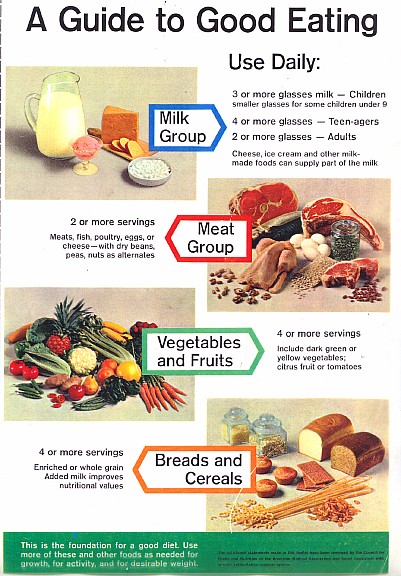 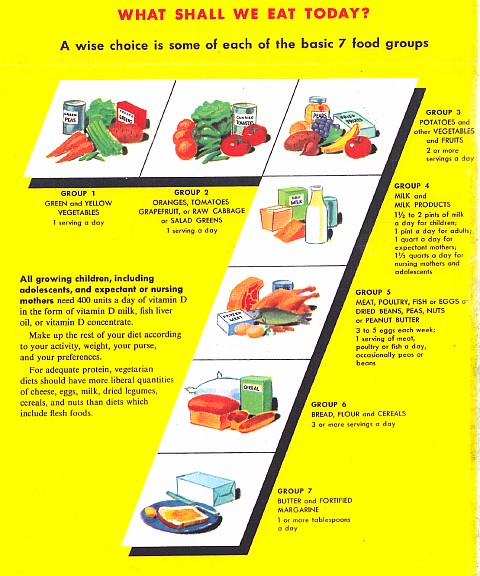  Returning to the U.S. MyPlate (http://www.ChooseMyPlate.gov,) MyPlate encourages people to take a balanced approach and to eat a variety of nutrient dense whole foods. To help people control calories and prevent weight gain, the USDA promotes the concept of nutrient density and empty calories. Controlling Calories: Nutrient density and empty calories. Nutrient density measures nutrients provided per calorie of food. For example, in the screen shot below, a 90% lean 3 ounce ground beef patty is considered more nutrient dense than a 75% lean patty. In the 90% lean patty, for 184 calories you get protein, iron, and other needed nutrients. On the other hand, a 75% lean 3 ounce patty has 236 calories, but the extra 52 calories add only solid fats, and no other appreciable nutrients.
See page 52 in Chapter 2 of your textbook the definition of empty calories. The idea is to choose
minimally processed foods in each food group that have few or no
empty calories, as these are the most
nutrient dense foods. Examples of foods HIGH in empty calories:
Can you think of how empty calories might actually help you to eat nutrient dense foods? I don't know about you, but I love putting butter on my cooked vegetables, or honey on my whole grain toast or oatmeal. Adding a little fat and sugar sometimes can enhance the flavor of nutrient dense foods. This is a great way to spend empty calories. They will come packaged with other nutrients, unlike drinking a soda packed with calories and no other nutrients. MyPlate Food Plan: MyPlate makes recommendations for the number of servings to eat daily from each food group. The number of servings from each food group and the maximum amount of empty calories recommended depends on energy (calorie) needs. Below is a screen shot of a food plan developed from the Dietary Guidelines/MyPlate for an adult who needs 1600 calories per day (why they didn't display the plan in a plate form is beyond me...): 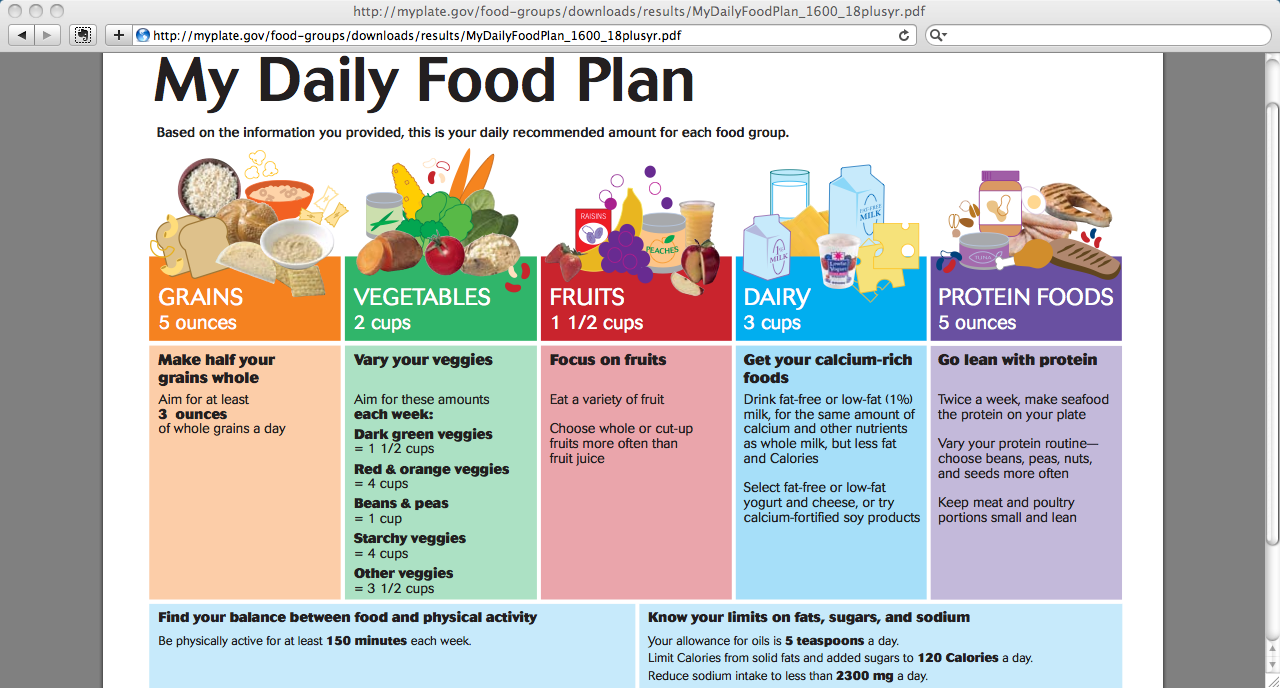 As shown above , a person needing a 1600 calorie diet may need only 1480 calories of nutrient dense foods to get their needed nutrients. The difference between calories needed to maintain weight and calories needed to provide needed nutrients (about 120 calories) are calories that can be spent on extras like solid fats, added sugars, foods low in nutrient density, or extra servings of nutrient dense foods. When choosing your food selections from the different food groups, most of your choices should be nutrient dense in order to meet your nutrient needs with out exceeding your calorie needs. For example when choosing dairy products they should be non-fat dairy products with no added sugar, like non-fat milk. If instead you chose strawberry flavored, whole milk you would be consuming empty calories due to the fat content and the added sugar. In general
the most nutrient dense food choices from the food
groups are minimally processed
fruits, vegetables, whole grains,
non-fat dairy, lean meat, fish and
skinless poultry, beans, nuts, and seeds that do
not have added fats or added
sugars. |
||||||||||||
|
Portion Distortion: 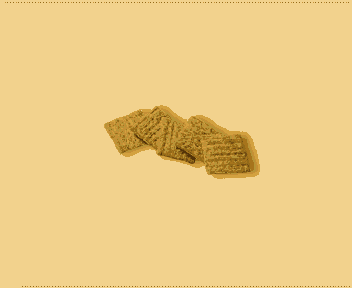 The measurement of that ounce of dry weight varies. You can see in the above image that an ounce of Triscuit crackers is about 5 of them. An ounce is equal to about 30 grams. Dry cereal usually gives the gram weight and the cup measurement.
There is now considerable "portion distortion" in what we think of a serving, as illustrated below. |
||||||||||||
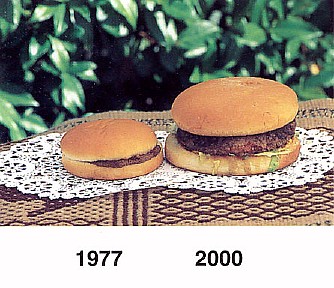 |
||||||||||||
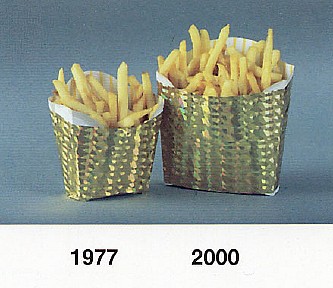 |
||||||||||||
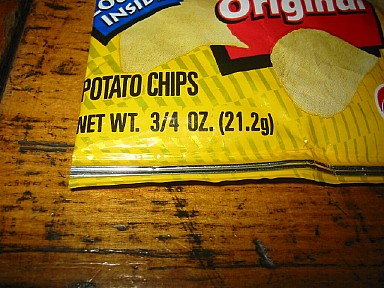 |
||||||||||||
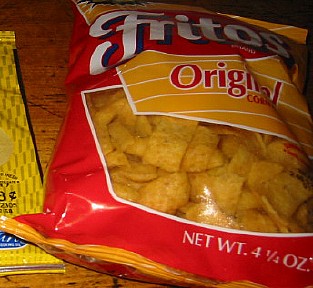 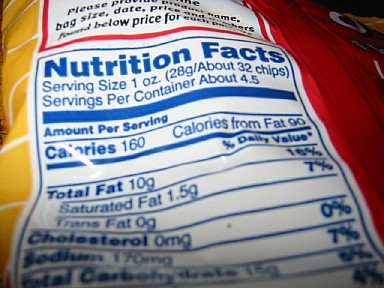 4 1/4 oz. Bag Fritos: 4.5 servings per container The Nutrition Facts
are given for 1
serving.
Do you see where the label says Calories 160 160 calories times 4.5 servings per container= 720 calories/bag |
||||||||||||
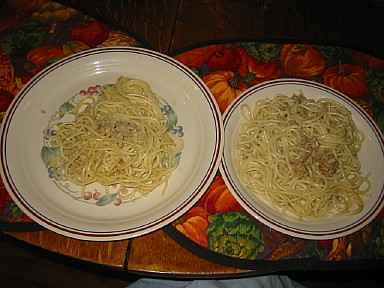 If you're trying to
cut down your portion sizes, one way to do it is to
use smaller plates. These are each one-cup portions
of spaghetti.
|
| V
Beyond the
nutrients of the twentieth century Definition- chemicals
that plants make to help them survive and get ready to
reproduce. Phytochemicals help them do that by helping
Lycopene is an
example of a phytochemical and food companies are
anxious to use them to market their products.
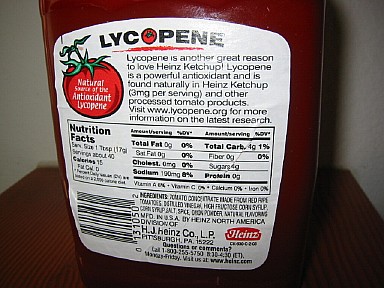 It is estimated that
there may be more than 100 different phytochemicals in
just one serving of vegetables.
In her book, Animal, Vegetable, Miracle: A Year of Food Life, Barbara Kingsolver says that a head of broccoli contains more than a thousand phytochemicals. (page 60) Some companies
selling supplements imply theirs is better than others
because it has "whole food". Nutrition Action,
in December 2007, said that once dehydrated, a serving
of fruit or vegetable (1/2 cup broccoli, for example)
would fill some 15 capsules. ("Juice Plus Commission")
B. Zoochemicals are the same thing in animals. C. Nutraceuticals- (term first used in 1989)- a term that
motivates companies to divide food into individual
chemicals that may have medical or health benefits,
including the prevention and treatment of
disease. These nutraceuticals are then sold at
a much greater profit than what a farmer makes when
selling a whole food.
Example: Benecol
margarine
  The label says that
“Plant stanol esters, the unique ingredient found
only in Benecol products, are derived from natural
plant components found in vegetable oils such as
soy.
….its proven ability to lower cholesterol is supported by over 25 studies, including one reported in the New England Journal of Medicine.” I purchased this 1-cup tub of margarine so I could take a photo of it. I eat butter because I love it's flavor and I'm very satisfied with just a little of it at a time. So I gave this tub to a friend who uses margarine. They returned it because they didn't like it. Look at the price for this this 1-cup tub (2006). 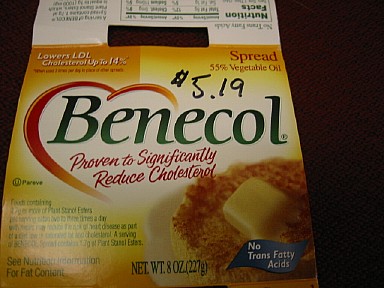 The Benecol implies that their plant stanols come from vegetable oils like soy, saying that they "are derived from natural plant components found in vegetable oils such as soy." Plant stanols are also found in wood pulp. C. The best way to get phytochemicals is by choosing a variety of whole plant foods, such as fruits and vegetables and whole grains. I can't remember where I read or heard Michael Pollan (a contributing writer to the New York Times Magazine and a professor of journalism at the University of California, Berkeley) talking about this. He said that for quite a while we've been encouraged by companies to buy their  Now we're being encouraged by companies to buy their "pill in a meal".
The end of Lecture 2A |
